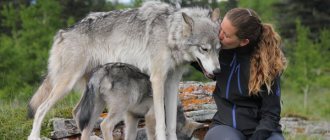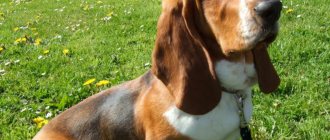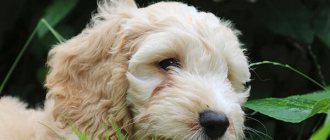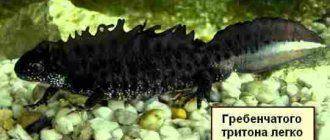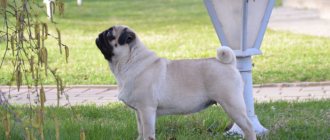Did you know that wolf-dog hybrids are... excellent diagnosticians who can detect cancer in a person by the smell of blood? By the way, the wolfdog breed itself is distinguished by excellent health. But these are not all its advantages. Crossing a wolf with a dog is real. It is quite possible for a wolf to have offspring with an Alaskan Malamute or Husky. But only a hybrid of a shepherd and a wolf is considered a real wolf-dog. These include only two types - Czechoslovakian Wolfdog and Saarloos Wolfdog. The breed is not recognized by the Fédération Cynologique Internationale.
History of the breed
Scientists believe that the first time a person tried to cross a dog with a wolf about 10 thousand years ago . But the end result was difficult-to-train, rather aggressive animals.
The first more or less successful attempts began only in the last century. So, in 1925, Lander Sarlos received his first litter from a shepherd dog and a domesticated she-wolf, Flora. The Saarloos wolf dog is quite popular in its homeland, it is used as guide dogs or bloodhounds. The Saarloos wolf dog is not very suitable as a working dog.
The Kunming Shepherd was developed in the mid-1950s. Outwardly, it looks like an ordinary shepherd, but only with long legs. Outbred dogs were used for breeding.
In the middle of the last century, Czechoslovakian Colonel Karel Hartl was involved in breeding shepherd-wolf hybrids. In 1989, the Fédération Cynologique Internationale recognized a new breed – the Czechoslovakian Wolfdog was classified as a herding breed. Today she is considered difficult to educate. There were experiments in Russia, for example, dog handlers from Perm did this. But the most successful attempt is a hybrid of the titled male Schnapps and the tamed she-wolf Naida . This was in the early 2000s.
Any breed that has at least 10% wolf blood . The amount of blood can be determined by the prefix with the letter F: if one of the parents is a wolf, the dog is given the marking F1, F2 means that the puppy’s grandmother was a wolf. Other varieties include the Haskovolf, Swisswolf, Wolfhund and Wolamute .
The reason why the IFF does not recognize wolf-dogs may lie in the fact that they have a difficult character and are difficult to train. Perhaps over time this problem will be solved. Despite everything, the wolf-dog hybrid is popular: many nurseries successfully breed and sell them.
What to feed a wolfdog
The main condition for feeding an animal is a balanced diet. It is not recommended to give dry dog food and abuse sweets. The wolf dog loves to chew on marrow bones.
The daily dog menu at the Perm Institute was:
- Porridge – 700 gr.
- Meat – 500 gr.
- Vegetables – 200 gr.
The generational bond between wolf and dog requires raw meat and fresh fish. It is recommended to give these foods regularly.
The owner of a wolf-dog must be a strong person, a leader by nature, and demonstrate such behavior to the animal. The owner must show character without showing fear. Otherwise, it will not be possible to cope with the dog’s disobedience; a large animal is capable of subjugating a person.
Interesting Facts
- In 2010, 300 thousand wolf-dogs were registered in the world;
- The more dog blood, the more aggressive the wolfdog;
- These animals can easily live in an apartment, but feel best in a private home;
- A cross between a shepherd and a wolf is better trained by women than by men. There are no explanations for this feature yet;
- Their favorite delicacy is not meat, but... sweets. They go crazy over sweets, marmalade, marshmallows, chocolate;
- *The highest quality hybrids are obtained if the father has a balanced character and is loyal to people;
- They love to lick their owner's teeth...
- There is no rabies vaccine for wolfdogs;
- They howl more often than bark.
Where do wolfdogs work?
The hybrid of a wild wolf and a domestic dog in Russia is currently being sectioned specifically to serve in responsible positions where ordinary dogs cannot cope with the assigned tasks. Animals are acquired by power structures to work in extreme situations in cold conditions, in the Arctic, or where an exceptional sense of smell is needed. They mainly serve on the border, in drug control departments and in regions where hostilities are taking place.
Kennels willingly lend social animals for photography projects. During filming, there is always a breeder or owner next to the wolfcop, who monitors the behavior of the pet and the safety of people. However, no cases of aggression were recorded.
Wolfdogs also appear in films. They are used where it is necessary to film an episode with a predator, but since wolves are unpredictable, they are replaced with hybrids.
Description of the breed
Outwardly, they most resemble a wolf, especially if it is a hybrid with a husky or shepherd, but the genes take their toll: they are smaller in size. So, an adult male at the withers has a height of up to 60 centimeters and a weight of up to 50 kg. Bitches weigh up to 40 kg and height up to 55. They usually have a strong and massive build, strong paws and powerful jaws. Most often the animal has a wolf bite, which is why they are stronger than any dog.
Sometimes you come across particularly large individuals with a height at the withers of up to 75 centimeters . Wolf genes play a role here.
Wolf dogs adapt quite easily to changes in life. The character and appearance of a dog most of all depends on how many wolf genes they have, on what breed took part in the crossing. But in general, their strengths are several. So, they have excellent health; such hybrids are not prone to “canine” diseases . They are ready to faithfully protect not only the house, but even the owner’s car, not to mention the owner himself. Usually they are equally attached to all family members, but they still treat women better. Another advantage is their ability to observe - the wolf dog perfectly sees strangers on its territory.
They need special training. You must understand that you adopted a wild animal, and not a domesticated one, even if it was many thousands of years ago. The most aggressive animals are those that have more than 20% wolf blood and those that have lived in a confined space for a long time. Wolfdogs are not recognized by the International Canine Federation, but this does not mean that they do not have standards. Yes, they look like wolves, but there are still differences.
Color
Gray, but a lot depends on what breed the wolf was crossed with. The more wolf blood, the darker the animal will be. Spotted and off-white colors are also found. Rarely, but there is a black wolfdog.
If this is a classic wolf-shepherd hybrid, then typical shepherd colors are possible:
- Black-and-white. The top is a dark V-shaped spot on the sides, belly and top of the tail. The bottom is lighter. May be fawn, light brown or light grey.
- Zonal. This color is also called wolf color. At the base the coat is light, then dark, then yellow and dark tips. The shade can be any.
- Black. There should be no light marks here. If crossed with a Belgian Shepherd, the wolfdog may have a yellowish-brown color.
Standards
Animals are tough. With well-developed muscles and a lean figure. The sizes are large, the skeleton is strong.
Head
The forehead is in the shape of a blunt wedge, quite wide. The muzzle is elongated, wolf-like. The nose is straight, expressive, the skull is wide. The eyes are almond-shaped, small in size, and the iris is amber. The gaze is studying and wary. The bite is either pincer or scissor. The ears are set high, medium in shape, pointed, triangular.
Neck
The dog has a rather long, strong neck. The neck is very muscular, slightly expanding towards the body.
Body
The body of the wolf-dog is rectangular, lean, muscular. It has a straight back with lean sides. The croup is powerful and the transition to it is smooth. The paws are longer and larger than those of a dog.
Tail
The dog-wolf hybrid has a thickened and long tail part of the spine. The landing is high. The tail is lowered down in a calm state. It cannot be stopped.
Limbs
As mentioned above, wolf-dogs have muscular and long, slightly closer paws.
Movements, plastic
Wolf dogs are very mobile, they can easily cover long distances. They jump high and run fast. While moving, the wolf-dog powerfully pushes off the ground, placing its limbs parallel to each other.
Wool
Thick, fits tightly to the body. The guard hair is smooth, straight, hard. There are more dense parts on the inner thighs and neck. Wolf dogs have a soft and thick undercoat. Occasionally, long-haired wolf dogs are found.
Character
Most of all, the character of a wolf-dog depends on how many wolf genes have been passed on to it. But there are also common features. This breed is most suitable for official purposes. What is definitely not in their nature is uncontrolled aggression. It manifests itself only with improper upbringing, so it all depends on the owner. The wolf dog easily tolerates cold and hunger . It can dull the feeling of hunger and survive even a long hundred-kilometer hike. In general, a wolfdog and a human may well be friends and collaborators.
It is difficult to predict the character of an animal even if wolves with a stable character took part in the crossing - puppies can still be born aggressive or timid .
The most “successful” hybrids are those with excellent instincts , which are actively used during search operations. They can also dominate their owner. If several animals live in a house, they either do not get along with them or become leaders. In other cases, they, like ordinary dogs, choose a leader - an authority figure in the family . If the owner lacks leadership qualities, the wolfdog may become an uncontrollable animal and simply not recognize a person with a gentle character.
Why are biologists against breeding the wolf dog breed?
Biological scientists are sounding the alarm and believe that the interbreeding of wolves and dogs in the natural habitat of predators can lead to the displacement of wolf populations from their habitats. More frequent mating events may have a negative impact on the destruction of the genetic identity of the gray predator.
Breeding such species for commercial purposes is also criticized by scientists. They claim that most of the offspring from such breeding die a year after birth. And hybrids that have reached puberty are threatened with death at the hands of humans because at this age wolf traits are clearly manifested in animals. At the age of 3-4 years, these half-breeds feel like either dogs or wolves. They cannot decide on their nature.
Common myths about the half-wolf
The unusual exterior and temperament characteristics of the wolf-dog, combined with the ignorance of ordinary people, led to the emergence of myths. What is true and what is false, we will try to figure it out together with you.
Myth 1
Huskies are half-wolves. This is not true. To the question: is a husky a wolf hybrid? There is a clear answer. No, it doesn't apply. The Siberian Husky is a breed of dog. There is no wolf blood in the veins of a husky.
Myth 2
A mixture of a wolf and a dog is an ideal guard breed. It's a delusion! Wolves are more shy, and their aggression is uncontrollable, so mestizos are not suitable as watchmen.
Myth 3
Mixed wolves live longer than dogs. Another erroneous statement. In captivity, wolves live 12-14 years. This is comparable to the average lifespan of any large dog.
If our article has not dissuaded you, you still want to get yourself an exotic, spectacular pet, think about other breeds. There are many domestic dogs in the world that look like a wolf, but have a calm disposition and are human-oriented.
Yuki - America's most famous wolfdog
Health and illness
Wolf dogs differ from dogs in excellent health. This is due precisely to wolf genes. They do not need regular vaccination, and some experts believe that vaccines do not work on wolves. According to dog handlers, hybrids need the help of a veterinarian three times less often than a regular dog. Many of them live 20 or even 30 years , maintaining an excellent sense of smell and vigor until a very old age, which allows them to serve for many years without respite. However, sometimes they have diseases characteristic of shepherds.
Cataract. Treatment consists of constant instillation of various taurine-based drops. This needs to be done daily and for many years.
Anomalies of the skeletal system. This occurs if the animal’s muscles are inherited from a wolf, and its bones are inherited from a dog. Sometimes this leads to deformity. The congenital disease is poorly treatable. A diet rich in calcium and vitamin D can help.
Cryptorchidism. It occurs when one or two testes do not descend into the scrotum. The disease is hereditary. It is treated either by plastic surgery or by injections of testosterone and gonadotropin.
Gastrointestinal diseases. Appear as a result of improper feeding. Treated with diet correction.
Joint dysplasia. They make themselves felt in the form of lameness, severe pain and inflammatory processes. Often treated with surgery or diet and vitamin D supplements.
Rabies. It cannot be treated and is fatal.
Also, wolf-dog hybrids may have diseases of other breeds, depending on who the wolf was crossed with.
How to properly deal with half-wolves
To keep an exotic half-breed pet, you will need to create special conditions and learn how to handle them. Without certain knowledge of the physiology and psychology of mixed breeds, this venture may turn out to be a failure at best. And at worst, lead to serious irreparable consequences for both the pet and its owner.
These types are not suitable for home apartment maintenance. Throw away the idea of getting a wolf hybrid if you only have a city apartment to spare.
For content you will need:
- Lots of space away from other people and noisy highways. A farm somewhere in the forest is an ideal place to keep this breed. The following habits were passed on to the hybrids from wolves: howling loudly and constantly wandering. They need the presence of wildlife to explore. There they will not disturb their neighbors with their howling, and the noise from cars will not frighten the pets.
- The space in which wolves are kept must be at least 0.2 hectares per individual. This should be a securely fenced area with a high fence (2.5 meters) so that the animal cannot jump over it. And a deep concrete foundation so that the pet cannot dig under it.
- It is best to enclose the space for keeping hybrids with a double fence with teeth curved inward.
- It is necessary to ensure good soil drainage in the area so that animals can find dry areas in rainy weather.
- The booth is not suitable for keeping wolfdogs. It is necessary to build a spacious house with a high shelf so that the pet can occupy a position on a hill.
- Low-growing shrubs and trees should be planted on the site so that the animal finds shelter in the heat. It is unacceptable to plant tall trees near a fence - the pet may run away!
- The gates are installed high - 1.8-2 meters. Gate latches must be reliable.
Important: immediately evaluate your ability to create the right space for keeping wolf hybrids. If you are not ready to provide your pet with such conditions, give up the idea of getting a wolf-dog.
Are wolf-dog hybrids trainable?
Mixed breeds of wolves and dogs are naturally intelligent and quick-witted. But they are also stubborn, self-willed and very energetic. To keep your pet in good shape, you need 1 to 3 hours of physical activity per day. You need to walk them a lot and actively.
Let's look at the educational and training features of wolf-dog hybrid dog breeds.
- The offspring of wolves and dogs are more difficult to train. These puppies have stronger instincts and are ready to follow them.
- The person must immediately indicate to the pet that he is in the role of the alpha male. Weak owners will not be able to constantly maintain this position. The pet will always try to take a dominant position, expressing this through disobedience to the person, refusal to follow commands and demands.
- Half-breeds have a strong fear of new situations and people - this makes training difficult.
- Toilet training on the street causes certain difficulties. Wolves are accustomed to marking their territory with feces. When they defecate at home, it is a territorial instinct, not a protest.
- Wolf instincts and aggression can trigger at any moment. A pet can attack a child, another pet, livestock or bird.
Husky Wolf Mix – a hybrid of a Siberian husky and a wolf
How to feed breeds that are wolf-dog hybrids
Conventional dog food is not suitable for feeding hybrid breeds. The diet of such a dog should consist of fresh meat. The best options are wild game, elk, bison, beef, lamb, rabbit, chicken and turkey. Pork causes digestive problems and should be avoided.
The meat is given raw along with the bones. Bones are not a problem for wolf descendants. They do a great job with them. The descendants of wolves do not need cereals. Pets are given fruits, vegetables and fresh herbs as sources of vitamins and fiber. The area where the pet is kept must have grassy soil so that the animals can eat grass.
To compensate for the lack of vitamins and minerals, you need to give fortified supplements as prescribed by your veterinarian. Particular attention should be paid to access to fresh fresh water. It is best to organize a drinking trough on the site, similar to the kind they make for keeping livestock. During the hot season, it would be a good idea to place a children’s pool on the property so that your pet can drink and swim in it.
Health of wolf-dog hybrids
Crossbreeding species with different genetics has a positive effect on the health of the offspring. Puppies that result from mating between wolves and dogs are much stronger and healthier. They do not exhibit those breed genetic pathologies that are inherent in purebred dogs. This proven fact was the main reason why people wanted to crossbreed dogs with wild carnivores. But such crossing has its pros and cons.
Upbringing
It is believed that the more wolf genes a representative of this breed has, the more difficult it is to raise him. In fact, even in one litter there can be both docile animals and wild ones with a wolfish character. Education is usually carried out by professionals, and it is aimed at developing service qualities - after all, this is not a couch potato, moreover, they are very active and willful. But what else can wolves be?
Wolf dogs are nocturnal animals, so it is best to train them in the evening.
- If you nevertheless decide to have a hybrid of a dog and a wolf not for service, but for friendship, then you need to educate him from the very first days .
- The main thing they need is constant contact with a person , preferably a kind but strict one.
- They definitely need to be tamed to human hands.
- It will be good if the puppy has contact with peace-loving ordinary dogs. Still, it is better to entrust this process to a professional. Perhaps his educational measures will seem harsh to you, but this is the nature of the breed.
- They do not have a close connection with a person , but this is good for the service, because one owner here can easily replace another.
- You need to treat the animal with firm respect , and he simply will not tolerate beatings and humiliation.
Appearance
Size varies depending on the sex of the wolf-dog and the dog crossed with the wolf.
Weight ranges from twenty-three to thirty-eight kilograms. Height from sixty-eight to eighty-three centimeters. Standing on its hind legs, the average wolfdog will be level with a person.
Description of the wolfdog breed:
- short, even coat with a thick undercoat that fits close to the body;
- strong limbs slightly close to each other;
- elongated muzzle, straight nose;
- yellow-amber small eyes;
- wedge-shaped head with a wide forehead;
- the symmetrical jaws have forty-two teeth;
- sharp wolf fangs;
- pointed triangular ears pointing upward;
- wolf-dogs howl like dogs, but cannot bark;
- tail set high;
- record high life expectancy of twenty to thirty years.
- The most common colors are black and gray. It can be black and gray, dirty white.
Maintenance and care
This breed is clearly not for home keeping. Therefore, he needs a warm booth and an impressive enclosure . As a last resort, you can let the dog-wolf warm up in the dressing room in the most severe frosts. But he needs a lot of personal space, so before buying you need to organize a large yard . It will be good if there are several exercise equipment for dogs , since the animal is very active. They usually tolerate low temperatures and rain well, as well as heat.
The yard must be well fenced so that the wolf dog cannot leave the site. This breed is prone to wandering and can become attached to stray dogs or even its own blood brothers. In addition, they have a developed hunter instinct, so they need to protect their neighbors as well.
Hygiene rules
Wolf dogs do not require special care; they are quite unpretentious, like all wild animals. But they have one peculiarity. They shed twice a year, and during this time the coat should be looked after quite intensively. Otherwise, caring for a wolfdog is almost the same as caring for a regular dog.
The animal should be accustomed to hygiene procedures from the first days. It will be difficult later.
The coat is combed once a week. But if shedding occurs, it is best to do this every day.
Bathing is recommended once every 6 months.
your teeth , but you need to purchase bones specially designed for cleaning teeth at a veterinary store.
The eyes should be examined every day, removing discharge as necessary.
your ears every three to four days. If you're worried about ear discharge, it could be an infection, so it's best to go to the vet.
claws , as they grind down on their own.
Nutritional Features
Wolf dogs are not particularly whimsical in food, because in nature they are quite omnivorous. For the same reason, you should not feed them wet and dry food, even holistic food - they can harm the animal’s health. So only natural nutrition , but it is important that protein significantly predominates over carbohydrates .
- It is recommended to feed your pet boiled meat with the addition of cereals (buckwheat, oats).
- It is better not to give meat raw.
- By-products are acceptable.
- The wolfdog's menu should also include vegetables, preferably boiled ones.
- You can give sweets and brain bones as treats.
Prohibited: nuts and legumes, garlic, millet, acorns and grapes.
You need to feed the wolf-dog once or twice a day. Puppies are fed six times a day.
Walks
The breed is in no way suitable for an apartment, so there is no question about walking. If you decide on such an adventure, then be prepared for four-hour walks for 20 years, or even more, and very active ones. A good option is to tie him to a bike and make him run. Moreover, the most active walk should occur in the evening.
Training
- Only a master with extensive experience should do this. But if you have raised more than one dog, you can supplement the training of a professional and take master classes from him.
- The animal has a wolfish character and habits. They are peaceful animals, but unpredictable and cunning. You need to be smarter than the wolf.
- When exercising, you should always have a treat with you, and this is not dry food. Ideally something sweet (they love it) or a marrow bone. In order not to be left without a finger, feeding is given in a fist.
- Train your wolf through play. He definitely won’t perceive you as an authority if you show aggression and beat him. First, achieve obedience, and then you can begin full training. But you must have a strict attitude.
- During training, you need to teach him to walk next to the owner, show his teeth, and approach the owner.
- First of all, you need to teach him simple commands: “Ugh!”, “Stand”, “Sit”, “Lie down”.
- You definitely need to master overcoming a barrier, a ladder, a fence, a boom and an inclined wall.
- Skill training should take place in any order.
- In the first lessons, you can study two teams per lesson, then their number can be increased.
Keeping a wolfdog at home
Wolf dogs are freedom-loving animals and are not intended to be chained or live on a sofa in an apartment. For them, the main thing is to maintain freedom and have a territory to move around. If you restrict a dog, it may become angry and aggressive towards its owner.
Attention! If they do not have the necessary physical activity, they can cause significant damage to the apartment due to boredom. They are allowed indoors only in severe frosts.
Hybrid breeds do not require special care. They do not need to be washed or combed daily. They are not picky eaters and can withstand bad weather conditions. The animals have a thick undercoat that allows them to survive in severe frosts. His unbridled appetite is well known, so a diet should be followed.
How to choose a puppy
It is impossible to buy such an animal in official nurseries, since they are bred only by law enforcement agencies for service. However, for 10 thousand rubles you can buy it in an unofficial nursery. A wolf dog with a strong psyche will cost 50 thousand or more . Things to consider:
- Percentage of wolf genes in the litter. The smaller it is (but not less than 10-20% ), the greater the chance that you will buy a dog and not a wild wolf;
- Pedigree. Find out how purebred the shepherd was that took part in the crossing.
- Puppy temperament. It is best to choose the calmest one, but definitely not the most apathetic one.
Wolfdog is a complex breed. But it has its own characteristics. The fewer wolf genes you have, the more likely you are to have a dog rather than a wild animal. They are not suitable for apartment living. They need a spacious yard with a warm booth. They are unpretentious in care, but need natural nutrition. Only a professional should train him. If you are not a professional, but have raised several dogs, you can decide to experiment by raising a loyal friend.
Pros and cons of the breed
| + | – |
| Possesses physical strength and a keen sense of smell | The wolfdog is only half a dog, so it is not suitable for people without special education |
| Unique service dog | Not suitable for apartment living |
| With proper upbringing, he is loyal to his owner. | Not suitable for sharing with animals |
| Very easy to maintain | May be dangerous for children |
| Unpredictable temperament | |
| The breed is not recognized by the FCI, so there are no official kennels |
Wolfdog is a strong and independent creature. The instincts of a wild animal are strong in him, so he needs a tough and confident leader. These dogs should be trained by a professional. Otherwise, the consequences will be unpredictable.
Uneven fight
On the appointed day, many people gathered. The spectators surrounded the cage with the wolf in a dense crowd. No other animal has ever received such audience attention. Excitement grew and people began to make bets. Without exception, everyone bet on the powerful, battle-hardened dog, kept on a short leash by its owner.
In comparison with this gladiator, the wolf looked like a pitiful wolf cub, and no one had any doubt that this creature would certainly die in the first minute of the battle.
The wolf, despite the growing excitement of the crowd, continued to huddle to the floor in the corner of the enclosure, not understanding how he could attract the attention of these people, and only a subtle observer could notice the wild fire rarely flashing in his eyes. Suddenly the iron bolt clicked loudly, causing the wolf to flinch and turn around towards the sound.
Suddenly, the iron bolt clicked loudly, causing the wolf to flinch and turn around towards the sound.
Another animal appeared in the open door - a powerful and merciless wolfhound, who without hesitation attacked the wolf.
Everything started spinning, spinning in a whirlwind, and for some time, no one could understand who grabbed whom and by what. Everyone was waiting for the fight to end soon, which, for some unknown reason, did not come, as the fight between the two animals continued.
